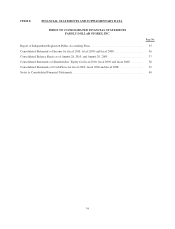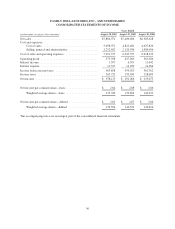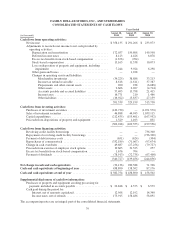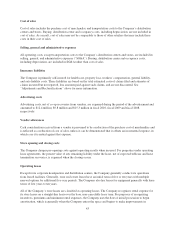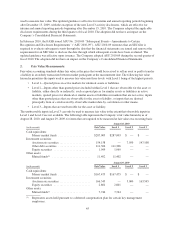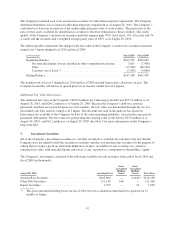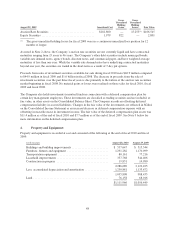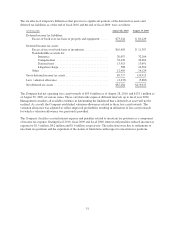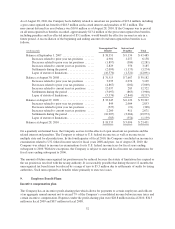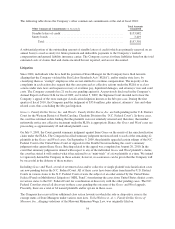Family Dollar 2010 Annual Report Download - page 48
Download and view the complete annual report
Please find page 48 of the 2010 Family Dollar annual report below. You can navigate through the pages in the report by either clicking on the pages listed below, or by using the keyword search tool below to find specific information within the annual report.preparation for intended use. For tenant improvement allowances and rent holidays, the Company records a
deferred rent liability at the inception of the lease term and amortizes the deferred rent over the terms of the
leases as reductions to rent expense on the Consolidated Statements of Income.
Certain leases provide for contingent rental payments based upon a percentage of store sales. The Company
accrues for contingent rental expense as it becomes probable that specified sales targets will be met.
Capitalized interest
The Company capitalizes interest on borrowed funds during the construction of property and equipment. The
Company capitalized $0.8 million, $1.2 million and $0.8 million of interest costs during fiscal 2010, fiscal 2009
and fiscal 2008, respectively.
Income taxes
The Company records deferred income tax assets and liabilities for the expected future tax consequences of
temporary differences between the financial reporting bases and the income tax bases of its assets and liabilities.
The Company estimates contingent income tax liabilities based on an assessment of the probability of the
income-tax-related exposures and settlements related to uncertain tax positions. See Note 8 for more information
on the Company’s income taxes.
Stock-based compensation
The Company recognizes compensation expense related to its stock-based awards based on the fair value of the
awards on the grant date. The Company utilizes the Black-Scholes option-pricing model to estimate the grant-
date fair value of its stock option awards. The grant-date fair value of the Company’s performance share rights
awards is based on the stock price on the grant date. Compensation expense for the Company’s stock-based
awards is recognized on a straight-line basis, net of estimated forfeitures, over the service period of each
award. See Note 11 for more information on the Company’s stock-based compensation plans.
New accounting pronouncements
In June 2009, the Financial Accounting Standards Board (“FASB”) issued a new accounting standard which
established the FASB Accounting Standards Codification (“ASC”) as the source of authoritative accounting
principles recognized by the FASB to be applied by nongovernmental entities in the preparation of financial
statements in conformity with generally accepted accounting principles (“GAAP”). Rules and interpretive
releases of the Securities and Exchange Commission (“SEC”) under authority of federal securities laws are also
considered sources of authoritative GAAP for SEC registrants. The ASC combines all non-SEC authoritative
standards into a comprehensive database organized by topic. The ASC is effective for interim and annual periods
ending after September 15, 2009. The Company adopted the ASC during the first quarter of fiscal 2010. The
adoption of the ASC did not have an impact on the Company’s Consolidated Financial Statements.
In September 2006, the FASB issued fair value guidance (ASC 820) that defines fair value, establishes a framework
for measuring fair value in GAAP and expands disclosures about fair value measurements. The Company adopted
the guidance with respect to financial assets and liabilities during the first quarter of fiscal 2009. The guidance
became effective for non-financial assets and liabilities for the first annual period beginning after November 15,
2008. The Company adopted the fair value guidance for non-financial assets and liabilities during the first quarter of
fiscal 2010. The adoption did not have an impact on the Company’s Consolidated Financial Statements.
In January 2010, the FASB issued Accounting Standards Update (“ASU”) No. 2010-06 “Fair Value
Measurements and Disclosures—Improving Disclosures about Fair Value Measurements” (“ASU 2010-06”).
ASU 2010-06 requires new disclosures for significant transfers in and out of Level 1 and 2 of the fair value
hierarchy and the activity within Level 3 of the fair value hierarchy. The updated guidance also clarifies existing
disclosures regarding the level of disaggregation of assets or liabilities and the valuation techniques and inputs
44


